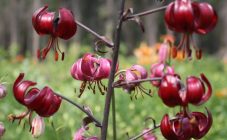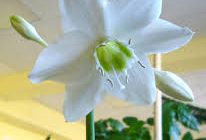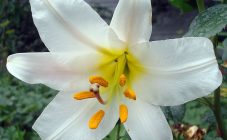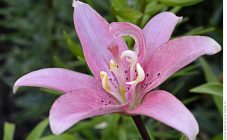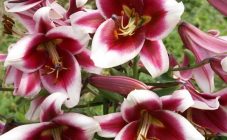Content:
Lily is a beautiful and delicate flower, which is very difficult to confuse with other flowers due to the shape of its petals and buds, as well as its persistent rich aroma. Due to the strong smell it is very difficult to keep it at home, but it will be an irreplaceable decoration in the garden. One of the brightest representatives of the varieties is the Triumfator lily.
Description of the variety of lilies Triumphant
Triumphant, or Triumph - LO-hybrid, which was obtained by crossing longiflorum and oriental varieties. There is also a lily White Triumphant, the buds of which are snow-white.
Flowers of this variety bloom in the form of bells, gracefully looking to the side, crimson towards the middle, and are framed with white on the sides. Triumfotor has a stem height of almost 1.5 m, and a bud 25 cm in diameter. On 1 stem, 3-5 pieces can bloom. buds. It is combined in a flowerbed with both other varieties of lilies and other flowers: hosta, hydrangeas, roses.
The Triumphant lily usually gives its beauty and aroma in July-August, pleases the eye for almost 3 weeks. This variety is frost-resistant, it is not afraid of winters down to -30 ° С.
Lilia the Triumphant: planting and care
Lilies are perennial plants, so it is important to initially choose a suitable planting site for them, so as not to disturb them later. A transplant can contribute to the development of diseases. Since the flower requires special care and may not take root anywhere, it is better to think over the planting scheme in advance and prepare the site.
The place where the lilies will grow should be sunny. Moreover, the best option would be if the sun warms mainly in the first half of the day. The triumphant will not take root if groundwater passes somewhere nearby or water generally collects and stagnates. It is also important to protect this plant from gusty winds.
The bulbs of this plant are planted on the site in April or May, or in the autumn months - September, October. In this case, they need to be sealed to a depth of three bulb sizes.
To protect lilies from insects and pests, experienced gardeners pour boiling water over the bulbs before planting the bulbs. Thus, without chemicals that can harm the flowers, they get rid of parasites.
In general, planting material should be planted in moist, loose soil. It will also be useful to fertilize the soil, as this will contribute to the early germination and, accordingly, flowering. It is important to keep the distance between plants at least 50 cm, then the flowers will have room, they will grow beautiful and lush, and the buds will be gorgeous. After planting, the soil is mulched with dry grass or peat.
You also need to take care of flowers correctly. It is necessary to water the lily only at the root so that water does not get into and does not remain on the leaves. As a top dressing, you need to use potash fertilizers, which help to strengthen the bulbs.
This variety is friendly to neighbors and quite peacefully able to live with other "inhabitants" of the flower bed. Thanks to the combination of crimson and white, it will look spectacular surrounded by bright colors.
Reproduction
Lily Triumphator can grow in one place up to 4-5 years. In adult representatives of this species, several nests of bulbs appear, differing in size and age. They are transplanted to a new place only after flowering. The optimal time is September - October.
But this is not the only way to reproduce this variety; experienced gardeners also practice the following methods:
- Leaves. When the budding process takes place, you need to pick several leaves from the flowers. They should be placed at an angle in a container with soil, half sprinkled. After about 40-45 days, the bulbs are formed.
- Stems. In autumn after flowering or in spring, it is separated from the bulb and planted in a flower bed. If the stem takes root, then in a month, at the most in one and a half, bulbs will appear on it. So that there are as many of them as possible, then that part of the stem that will be in the ground is cut longitudinally. But the lily in this case will bloom only in the second year.
- Scales. The bulbous bottoms together with the scales are planted in the ground. The soil is periodically moistened as needed. After 2-3 weeks, seedlings will appear, and small bulbs will form in the ground.
Lilia Triumph is tender and even a little capricious, therefore it is very important to maintain the correct breeding technology and patiently wait for the result, maintaining the necessary conditions. Otherwise, all efforts may be lost, and the attempt to increase the beauty of the garden will not be crowned with success.
Pests and diseases
Lily suffers from insects, rodents, various infections and fungal diseases. Therefore, it is important to properly plant the bulbs of these plants and provide the necessary care. Although the Triumfator variety is less prone to ailments than other representatives of this culture. Horticultural encyclopedias list many diseases that lilies are susceptible to, and for each of them there is a suitable remedy. The main thing is to carefully read the instructions. Malophos and phytosporin are in great demand.
Advantages and disadvantages of the variety
Lilia Triumfator really has some qualities that allow her to look more advantageous over other varieties:
- Color. Thanks to the combination of raspberry and white, it will fit into any flower bed and give it a special beauty.
- Disease resistance. This variety is less susceptible to disease if the bulbs are properly planted and the plant is looked after.
- Dimensions. Compared with some other varieties, it has larger buds.
- Smell. Many varieties of lilies have a strong odor, which is too harsh in the room, and sometimes even seems unpleasant due to the saturation. Triumphant smells softer and more delicate, and the aroma does not press on the olfactory receptors.
Everything in this life has its pros and cons, and the Triumfator variety is no exception:
- Fake. Many summer residents would like to contemplate such beauty in their flower beds. Unfortunately, some dishonest people who sell these flowers can deceive their customers. Instead of the bulbs of the variety described above, sell a completely different, cheaper one. And this happens not only with the Triumphant, but also with other expensive and rare varieties of lilies.
- The vagaries of planting and care. Like any other flowers, this lily has its own "wishes". This variety does not like drafts and poor soil, but few of the summer residents can boast of the absence of a breeze and the presence of soil that is completely suitable for growing.
Lilia Triumphator bears this name for a reason. She is really gorgeous and graceful, therefore she is very popular. But the flower will give its beauty only to those who will take care of it for a long time and painstakingly.



